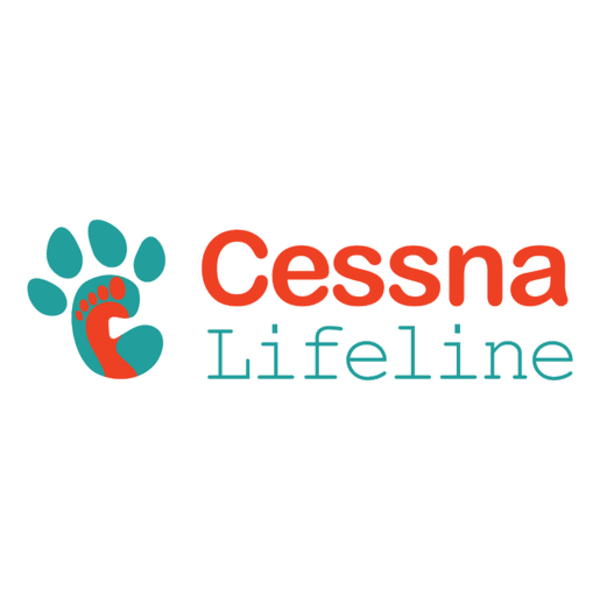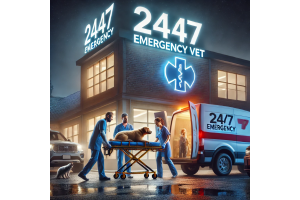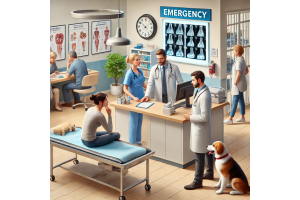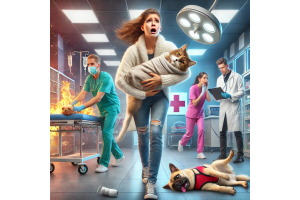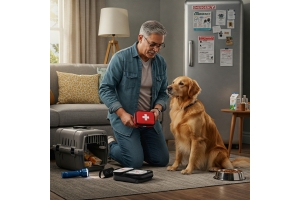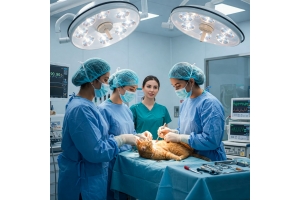Back to Top
Feline Lower Urinary Tract Signs, Idiopathic
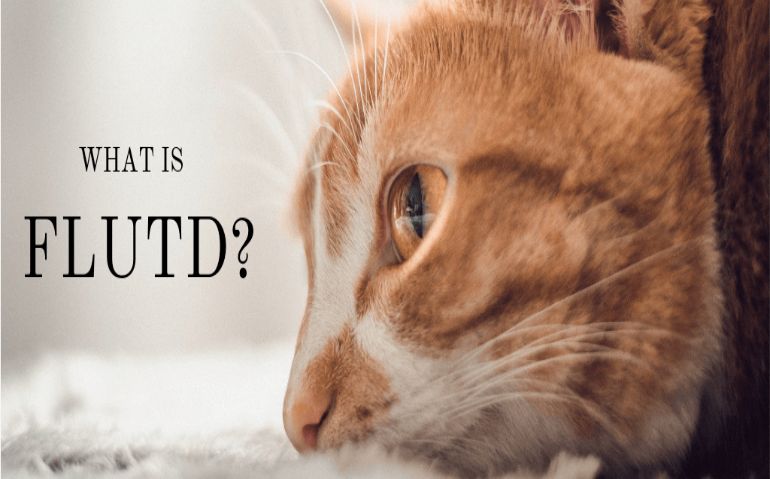
About the Diagnosis
Feline urinary syndrome (FUS), feline idiopathic cystitis (FIC), and feline lower urinary tract signs or disease
(FLUTS/D) are interchangeable names given to the same cluster of urination-related symptoms that cats often
display when they experience bladder problems. These symptoms include straining to urinate, frequent urination,
bloody urination, urinating outside the litter box, pain while urinating, and urinating small frequent volumes.
The unifying theme in these symptoms and syndromes is that there is no infection, no bladder stone, no behavioral cause,
and no identifiable defect in the urinary system. In other words, FLUTS/D is a disorder of inflammation and pain that
makes urination uncomfortable for cats but that has no defined cause. It is a very common problem in cats.
A cat is known to have this disease when he/she shows some or all of the symptoms described above in the absence
of all other urinary disease processes. Therefore, a series of tests is always necessary to try to identify other
problems, such as a bladder infection or bladder stone, which might cause symptoms similar to FLUTS/D but which
would require specific treatment (certain antibiotics, or stone-dissolving medications or diets, or even surgery) to
alleviate an identifiable problem.
Tests that are used for assessing urinary problems in cats include a complete blood
panel, urinalysis, x-rays, urine culture, and abdominal ultrasound. When a cat has symptoms of urinary difficulty and
these tests produce normal results, then FLUTS/D is considered to be the cause.
The characteristic problem of FLUTS/D is inflammation of the urinary bladder (cystitis). The protective mucous layer
that lines the inside of the urinary bladder is deficient in cats with FLUTS/D, which allows the harsh chemicals of the
urine to contact the deeper tissues of the bladder, causing irritation of the bladder wall. While much is known about
the symptoms and characteristics of cats with FLUTS/D, the exact cause of the disorder remains unknown. In this
manner, FLUTS/D is almost identical to a similar urinary syndrome, interstitial cystitis, which occurs in humans,
especially middle-aged women.
In some cats, the diagnosis of FLUTS/D may be unclear. A good source for a second opinion is an internal medicine
specialist veterinarian (directories: www.acvim.org [North America];www.ecvim-ca.org [Europe]) and you should
speak with your veterinarian about seeing one of these specialists as necessary.
Living with the Diagnosis
First and foremost, it is essential to determine if a cat with these symptoms has an identifiable and treatable disease
that can be eliminated using appropriate treatments (antibiotics for a bacterial infection, diet therapy or surgical
removal for stones, etc.). This requires the tests described above. Without these tests, inappropriate medications and
unsuccessful outcomes (symptoms persist or worsen, adverse reactions to medications) are common.
Second, if the tests are negative, which confirms FLUTS/D (by exclusion), other potential causes of inappropriate
urination need to be eliminated from suspicion. A simple and vital preventative step you can take is to make sure that
the household has several litter boxes (one for each cat, plus one additional box) and that they are entirely cleaned
daily. It can be useful to observe your cat urinate to make sure the cat squats (not standing and marking vertical
surfaces) and to observe the volume of urination. Is the puddle the size of a quarter? Is it like a cup of water spilled?
This information will be extremely useful to the veterinarian in assessing the possibility of FLUTS/D.
Third, a factor that is commonly felt to cause or worsen FLUTS/D is stress. This may be identifiable (construction in
the home, recent move, a new baby, puppy, or kitten in the home), or it may be more subtle. Reducing and removing
stress when possible will often help or even eliminate symptoms of FLUTS/D.
Finally, if the stress initiator cannot realistically be removed, then there are some medications that may be beneficial.
Often symptoms will resolve on their own within a few weeks, independent of any medication or changes in the home.
The difficult problem is that symptoms often come back. Some cats can have a bout of FLUTS/D that lasts a couple
of weeks and resolves on its own without treatment and never have a problem again. Other cats with FLUTS/D
develop symptoms every couple of months and have problems for weeks on end each time. Your cat may be on
either end of this spectrum of severity or somewhere in the middle.
Treatment
Increase water intake. Ways of encouraging cats to take in more water include: providing plenty of clean and fresh
water sources; making sure that bowls are cleaned regularly and water is changed frequently (at least twice daily);
providing wet cat foods; and providing a source of moving water (purpose-made cat water fountains or just leaving a
faucet that is accessible to the cat to drip several drops per minute). The goal behind increasing water intake is to
dilute the urine, which is less irritating to the inner lining of the bladder surface.
Psychological therapy involves identifying and reducing or removing stressors in the environment. Separating cats
into different rooms of the home can be useful if the cats have a tendency to fight or don’t seem to get along.
Providing a perch near a closed window so a cat can be distracted by the outdoors also can be helpful. Your
veterinarian can provide additional information on important and simple techniques for environmental enrichment that
may be as effective or more so than medications.
Hormonal or pheromone therapy has been suggested and recommended by many veterinarians. There are several
over-the-counter (nonprescription) products that are claimed to provide calming hormonal stimulation. Few if any of
these has been scientifically tested. There are many people who subjectively feel these provide significant benefit.
Glucosamine and chondroitin supplements are used for treatment of arthritis by many veterinarians and physicians. It
has been theorized that there may be benefits to an inflamed bladder if a cat is given a glucosamine and chondroitin
supplement. This is because the mucous layer of the bladder lining and the protective fluid of the joints are very
similar chemically. Many glucosamine and chondroitin supplements have been shown to be nontoxic and have few
side effects, but their benefits are unclear and still somewhat controversial. Use of glucosamine and chondroitin
therapy in cats with FLUTS/D shows some promise, but it is not a wholly curative therapy.
Nonsteroidal anti-inflammatory drugs have been theorized to aid in cats with FLUTS/D by directly reducing the
inflammation of the bladder and/or providing pain relief. A very limited number of these drugs is tolerated well by cats,
essentially all by veterinary prescription only. Be careful to NEVER give an anti-inflammatory pill or syrup to a cat if it
is a human medication; many of these are toxic to cats, and have been fatal with just one dose. Even prescription
nonsteroidal anti-inflammatory medications designed for cats may cause adverse side effects including
gastrointestinal irritation, gastric ulceration, and kidney damage. These medications should be administered only after
consulting with your veterinarian, at appropriate doses, and with frequent recheck to monitor for signs of adverse side
effects.
Opioid drugs are prescription analgesics (painkillers) that have been used for breaking the “pain cycle” of bladder
irritation and to provide relief from symptoms. These drugs are often difficult to prescribe and administer outside a
hospital setting, so they are reserved for cats whose pain level is so high that they require hospitalization. These
drugs also can have significant side effects and the hospitalization should include patient monitoring for these effects.
Anti-anxiety and psychotropic drugs are available for cats, and these also have shown some promise for treating
FLUTS/D. While few if any of these have been appropriately scientifically tested, they seem to help individual cats
and can be considered in difficult or persistent, recurrent cases.
DOs
· Test for -and eliminate the possibility of- different urinary diseases that could produce symptoms that mimic
FLUTS/D but actually are entirely different and require completely different types of treatments.
· Try to make realistic and reasonable adjustments to your household to reduce stress.
· Provide plenty of clean litter boxes.
· Try to increase water intake, provide clean fresh water, and wet cat foods.
· Consider trying over-the-counter “de-stress” hormones or pheromones as part of the treatment plan.
· Consider glucosamine and chondroitin supplementation. Cats only need a small amount; consult your
veterinarian for appropriate dosages. This can often be sprinkled on food, which means there is no need to
administer a pill.
· Consider nonsteroidal anti-inflammatory or opioid therapy; these should be done under the guidance of your
veterinarian for extreme cases. Follow-up monitoring is important with these drugs.
DON’Ts
· Don’t give up. Often, symptoms resolve on their own and may never come back. Give your cat some time to
heal.
When to Call Your Veterinarian
· Recurrence of symptoms.
· If symptoms change (urinating larger volumes, foul-smelling urine, worsening signs of pain, etc.).
· Signs of secondary side effects of medications including poor appetite, vomiting, diarrhea, and lethargy.
Signs to Watch For
Your veterinarian may ask you certain questions about what you see your cat do. Knowing the answer to these
questions can be very helpful in determining the severity of FLUTS/D, or even whether an alternate cause is the
problem instead.
· How is your cat actually urinating? Squatting or standing? Small amounts or large? Blood? Odor worse than
normal?
· Where is the cat urinating? On the bed? In the laundry, etc.? In one particular place or all over the home?
· When is the cat urinating? When you have guests? During the day or at night, etc.? This information can
help with the initial diagnosis and, of course, is useful for monitoring how the problem is
evolving—deteriorating or improving.
Routine Follow-Up
· Follow-up should be tailored to the specifics of each cat. Some cats will need more frequent rechecks (for
example, if taking daily medications). Others will respond quickly and will need few if any rechecks. Your
veterinarian can provide guidelines for rechecks that are appropriate for your individual cat.
